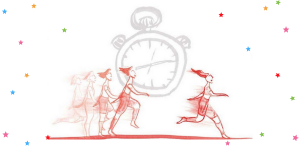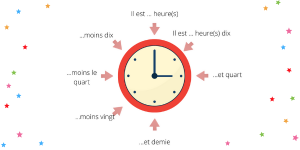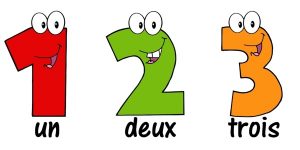Bilingual French-English books

It might appear difficult to raise your children between two cultures, ensuring that they master both languages, especially when they do not practise them everywhere. Reading bilingual French-English books allows children to navigate between the two languages as they please.
Months in French

You might already know French numbers or French days of the week, but what about French months? When learning a new language, it is crucial to begin with days and months, as you might have to use them everyday. For example, when taking appointments and dealing with deadlines.
As in English, most of the French months of the year are inspired by the Roman calendar, but with a few twists and turns of course! Below is a summary. We will explain each word in more detail.
● January is “Janvier”
● February is “Février”
● March is “Mars”
● April is “Avril”
● May is “Mai”
● June is “Juin”
● July is “Juillet”
● August is “Août”
● September is “Septembre”
● October is “Octobre”
● November is “Novembre”
● December is “Décembre”
French days of the week

Learning the days of the week in French is an easy and common first step to discover this complex language. It may also be useful if you plan on having meetings or travelling to French-speaking countries. What’s more, children tend to start by learning the alphabet, numbers, and days of the week.
Telling time in French

You might already know your French months and days of the week, but what about telling time in French? What are am and pm in French? How do you schedule an appropriate time for an appointment? You might have to review your French numbers before diving into telling time in French! Let’s going! The picture of the clock here is just a brief overview. Don’t worry, we’ll explain it all!
Nursery rhymes in French

Nursery rhymes are a great way to introduce your children to French numbers, days of the week, animals… while having fun. As little children are natural musicians, singing will help them memorize new things and discover French culture without even realizing! Maybe you are nostalgic of your own nursery rhymes, too!
French bedtime stories

Trying to teach French language and culture to your children? What could be better than reading them French fairy tales and bedtime stories? You can still count sheep; but you might have to review your French numbers before that!
French numbers for children and beginners

Counting is one of the first things you learn in a foreign language. It is also obviously very useful. There are no shortcuts to learning French numbers; you have to memorise them, by reading a story, playing a game or singing a nursery rhyme, for example. If you are starting from scratch, you may be interested in My First Counting Book.
In addition to counting in French, you may also be interested in learning the following with Storyplay’r’s French stories for children:
First let’s take a look at numbers from one to ten, then from eleven to sixteen (why sixteen, you ask? Keep reading to find out!), before learning a few rules on counting in French, such as how to use a hyphen, exceptions, and how to count to 100.
Along the way, you will not only learn how to write these numbers, but we’ll also give you some pronunciation tips and rules.
Counting in French: numbers 1-10?
Good news, you already know the first number, which is not one, but zero—“zéro” in French. You just have to add an accent on the “e”, which makes the very French “é”, as in “café”.
Let’s take a look at the other numbers. We’ll explain the pronunciation of each one, then give you a clear grid to memorise them more easily.
- ● One is “un”.
● Two is “deux”. Tricky one! You don’t pronounce the “x”!
● Three is “trois”. You still don’t pronounce the last letter, « s ». It’s just “tr-wa”. You have to get used to the French « r » sound, which does not exist in English.
● Quatre, “four”, also includes the « r » sound.
● Five is “cinq”. You don’t need the « u » after the “q” this time, unlike in “quatre”. There are only two words like that in French: “cinq” (five) and “coq” (rooster).
● Six is “six”. Looks the same, but you don’t pronounce the “x” as in English. Here, it sounds like an “s”.
● Seven is “sept”. You don’t pronounce the “p”.
● Eight is “huit”. You don’t pronounce the “h”.
● Nine is “neuf”. Here, you pronounce all the letters (Finally!).
● Ten is “dix”. It sounds similar to “six”, the final “ix” making the same sound.
Congratulations, you’ve learnt eleven French numbers! By the way, how do you say eleven? Be patient and read the next paragraph…
Counting in French: numbers 11-16
You will have to learn French numbers from eleven to sixteen by heart, as there is no simple and easy logic.
French numbers from eleven to sixteen are special numbers and all contain a “z”:
- Eleven is “onze”.
- Twelve is “douze”. Think of “une douzaine”, which looks like and means the same as “a dozen”.
- Thirteen is “treize”.
- Fourteen is “quatorze”. French people also use the term “quatorzaine”, which means a two-week long quarantine. It is derived from the French word for quarantine, “quarantaine” (close enough)!
- Fifteen is “quinze”.
- Sixteen is “seize”.
Counting in French: numbers 18-69
After eighteen, French numbers go back to following a more logical pattern. They are just composed of the corresponding multiple of ten (ten, twenty, thirty, etc.) followed by a hyphen, then a number between one and nine. This is why we call them hyphenated numbers.
There is actually an exception to this rule (this is French after all, it can’t be all too simple!) for 21, 31, 41, etc. but we’ll get to that later.
Usually, the hyphenated numbers follow this rule:
- Eighteen is “dix-huit”.It is pronounced “deez-weet”, because you link the “dix” sound to the next word, which begins with “hu”, considered as a vowel because the h is silent. In French, it makes the “z” sound, and is called a “liaison”.
- Nineteen is “dix-neuf”.Similarly, there is a “z” sound appearing between “dix” and “neuf”, even though “dix” on its own ends with the “s” sound.
As for the twenties:
- 20: vingt
- 21: vingt-et-un
- 22: vingt-deux
- 23: vingt-trois
- 24: vingt-quatre
- 25: vingt-cinq
- 26: vingt-six
- 27: vingt-sept
- 28: vingt-huit
- 29: vingt-neuf
Have you noticed the exception for 21? Instead of saying “vingt-un”, as the logic may suggest, you must say “vingt-et-un”, with the addition of « et », meaning « and ». In terms of pronunciation, there is another “liaison” between “vingt” and “un”: in “vingt” on its own, the “t” is silent. However, when there is a link between “vingt” and another word, you pronounce the “t”.
The same logic applies for thirty-one (“trente-et-un”), forty-one (“quarante-et-un”), up to sixty-one. Thus, the numbers 30 to 69 follow the same pattern.
The thirties:
- 30: trente
- 31: trente-et-un
- 32: trente-deux
- 33: trente-trois
- 34: trente-quatre
- 35: trente-cinq
- 36: trente-six
- 37: trente-sept
- 38: trente-huit
- 39: trente-neuf
The forties:
- 40: quarante
- 41: quarante et un
- 42: quarante-deux
- …
- 49: quarante-neuf
The fifties:
- 50: cinquante
- 51: cinquante et un
- 52: cinquante-deux
- …
- 59: cinquante-neuf
The sixties:
- 60: soixante
- 61: soixante et un
- 62: soixante-deux
- …
- 69: soixante-neuf
Counting in French: numbers 70-99
With French numbers 70 to 99, things get even more complex. Rather than using direct French equivalents of seventy, eighty, and ninety, the French use:
- the equivalent of “sixty-ten” (“soixante-dix”) for seventy, because seventy is sixty plus ten;
- “four-twenty” (“quatre-vingts”) for eighty;
- and “four-twenty-ten” (“quatre-vingt-dix”) for ninety.
And it’s only valid in France! In other French-speaking countries such as Switzerland, they do use equivalents of seventy (“septante”), eighty (“octante”) or ninety (“nonante”)!
Be careful: “quatre-vingts” ends with an “s” when it is not followed by another number. The “s” disappears if a number follows. For instance, in “quatre-vingt-deux” or “quatre-vingt-dix”, “vingt” does not end in an “s”.
It’s getting difficult, isn’t it? Brace yourself, there is more to come!
You might remember that “one” was an exception from 21 to 61 (“vingt-et-un” to “soixante-et-un”) and that 11 was “onze”. We will use a fusion of the two for 71 and 91, which give “soixante-et-onze” and “quatre-vingt-onze”.
But what about 81? It does not have an “et”. You will then say “quatre-vingt-un” instead of “quatre-vingt-et-un ». Also keep in mind that the “t” remains silent.
You are not done yet! From 70 to 100, all the numbers use their “10” equivalent. Then, 72 in French is “soixante-douze” (the equivalent of “sixty-twelve”). And, indeed, 72 is sixty plus twelve! 73 is “sixty-thirteen”, 74 is “sixty-fourteen”, and so on.
It’s the same for 90 to 100: 91 is “quatre-vingt-onze” (“four-twenty-eleven”), 92 is “quatre-vingt-douze” (“four-twenty-twelve”). But this isn’t the case for the 80s. Except 81, or “quatre-vingt-un”, there are only simple hyphenated numbers: 82 is “quatre-vingt-deux” (“four-twenty-two”), 83 is “quatre-vingt-trois”, 89 is “quatre-vingt-neuf”.
Below is a summary table. Take time to memorise all the new rules and exceptions.
Seventies:
- 70: soixante-dix
- 71: soixante et onze
- 72: soixante-douze
- 73: soixante-treize
- 74: soixante-quatorze
- 75: soixante-quinze
- 76: soixante-seize
- 77: soixante-dix-sept
- 78: soixante-dix-huit
- 79: soixante-dix-neuf
Eighties:
- 80: quatre-vingts
- 81: quatre-vingt-un
- 82: quatre-vingt-deux
- 83: quatre-vingt-trois
- 84: quatre-vingt-quatre
- 85: quatre-vingt-cinq
- 86: quatre-vingt-six
- 87: quatre-vingt-sept
- 88: quatre-vingt-huit
- 89: quatre-vingt-neuf
And the nineties:
- 90: quatre-vingt-dix
- 91: quatre-vingt-onze
- 92: quatre-vingt-douze
- 93: quatre-vingt-treize
- 94: quatre-vingt-quatorze
- 95: quatre-vingt-quinze
- 96: quatre-vingt-seize
- 97: quatre-vingt-dix-sept
- 98: quatre-vingt-dix-huit
99: quatre-vingt-dix-neuf
Counting in French: 100-1,000
Just like a hundred in English, 100 has its own word in French which is “cent” and counting above 100 is fairly easy. Between 100 and 200, you just have to put “cent” in front of the corresponding number between 1 and 100. Here are a few examples:
- 1 is “un”, 101 is “cent-un”.
- 11 is “onze”, 111 is “cent-onze”.
- 34 is “trente-quatre”, 134 is “cent-trente-quatre”.
After that, it’s quite easy until 1,000. Below are some examples to help you understand:
- 200 is “deux-cents”
- 300 is “trois-cents”
- 201 is “deux-cent-un”
- 401 is “quatre-cent-un”
- 234 is “deux-cent-trente-quatre”
- 734 is “sept-cent-trente-quatre”
Counting in French: numbers over 1,000
Just like a thousand, 1,000 has its own word in French, which is “mille”, and counting above 1,000 is easy. Just put « mille », « deux-mille », « trois-mille » and so on, in front of the corresponding number between 1 and 1,000. As before, here are some examples to illustrate:
- 1 is “un”, 1,001 is “mille-un”, 2,001 is “deux-mille-un”
- 101 is “cent-un”, 1,101 is “mille-cent-un”
- 11 is “onze”, 1,011 is “mille-onze”, 2,111 is “deux-mille-cent-onze”
Practicise French numbers with Storyplay’r’s French stories for children
Learn the other French numbers with our digital books. Take a look at these two stories with numbers: 10 moutons 9 dinosaures, by Maria Jalibert, and Compter avec un monstre, by Patrick Pasques.
There are also a lot more to choose from on Storyplay’r to practise French numbers and we even have a category of stories called Counting with French stories.
Reading and listening to a book on Storyplay’r will help you learn to count in French faster and more effectively. Even if you don’t understand everything yet, you will be able to follow the story thanks to the text and accompanying illustrations. Plus you’ll be practicing your listening comprehension skills without even realising!


















